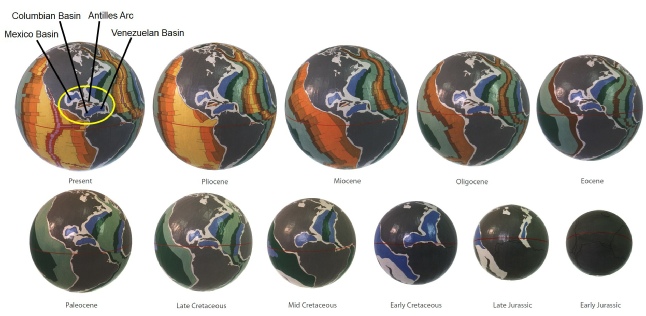

CARIBBEAN SEA
The Caribbean Sea is made up of the Mexico, Colombian, and Venezuelan Basins, separated by what is referred to as the Antilles Arc. On an Expansion Tectonic Earth the development and subsequent opening of the Caribbean Sea is intimately related to the continental plate motion histories of both South America and Africa, relative to North America. Geological mapping of the seafloor shows that opening of each of the Caribbean basins was most active during the Jurassic Period. This was then later reactivated along the Antilles Arc during the Paleocene—around 66 million years ago—and has continued to open as a relatively restricted basin to the present-

Caribbean Sea Expansion Tectonic small Earth spreading history, extending from the present-
Plate tectonic reconstructions of the Atlantic Ocean traditionally fit the Brazil and Guinean coastlines of South America and Africa together. This fit helps to minimise any misfit in the Caribbean Sea region. The Caribbean region is then seen as a buffer zone between the North American plate, the South American plate, and subducting oceanic plates of the Pacific Ocean. On these reconstructions the Caribbean region is considered to be a preserved piece of the ancient Pacific Ocean, referred to as the Farallon plate, which is inferred to have originated from outside of the Caribbean region.
In contrast, on an Expansion Tectonic Earth early development of the Caribbean Sea is intimately associated with opening of the North Atlantic Ocean along with subsequent rifting of Africa away from the Americas. Opening of the Caribbean Sea commenced during the Triassic to early-
This early opening phase lasted until the early-
From the Paleocene Period–around 66 million years ago–to the present-
On an Expansion Tectonic Earth, an external origin for the Caribbean crustal region, as proposed in plate tectonic studies, is unnecessary. Small Earth model studies show that sourcing a fragment of crust from the Pacific region is untenable and is inconsistent with the established seafloor geological mapping. Instead, opening of the Caribbean Sea region is shown to be intimately associated with opening of the North Atlantic Ocean as well as on-